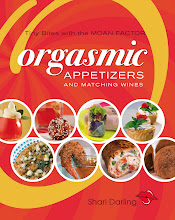Vegetarian Spring Rolls
A few years ago I volunteered to make all of the appetizers from my girlfriend’s wedding. After creating all the tasty bites, I had this feeling, a familiar one, that I just had not made enough food. When alcohol is being served at events like weddings, it’s important that guests have enough food so they don’t get too silly too quickly.
After rummaging through my cupboards, I came up with a package of rice papers and a few cans of tuna. In the refrigerator I found wasabi paste and mayonnaise. I had fresh greens on hand.
I made a stack of Tuna Spring Rolls with Fresh Herbs and Wasabi Mayonnaise. (Recipe below)
Interesting, my quick and easy spring rolls made with rice paper were the first nuggets to be demolished by hungry guests.
I decided to include this recipe in my most recent cookbook entitled Orgasmic Appetizers and Matching Wines – Tiny Bites with the MOAN Factor.
I love rice papers. They are so inexpensive and easy to work with. Because they don’t possess any real flavour, the filling is the most important element to consider when pairing with wine.
For a quick meal, I make vegetarian spring rolls with fresh avocado, tomato, lettuce, cucumber, and fresh herbs, like basil. Forgo the dressing. Toss the vegetables in fresh lemon or limejuice, and pair these simple treats with Sauvignon Blanc. The lemon flavours harmonizes with the wine. (See photo above).
This thin, almost translucent paper can be purchased in various sizes, from small to large, round and square. To use the rice paper, just fill a large bowl with warm water. Slip the paper into the bowl and let it soak until the paper becomes soft and pliable. Set the soft paper on the cutting board. Place your filling close to the end of the paper. Roll up the filling, tucking in the ends.
If you’re using the rice paper raw to make spring rolls or appetizers for weddings, be sure to use two papers per roll. The longer the rolls slit, the softer they become and will no doubt split. So, double up on the papers. Make your first roll, then wrap the roll in another sheet.
Rice paper treats can also be deep fried, pan fried or baked. Deep fried rolls taste great when paired with a dipping sauce. Be sure to take the taste sensations of the sauce into consideration when pairing your rolls with wine. Fill the rolls with left-overs like rice or salad and pan fry.
Limitless spring roll and wine pairings exist.
Salmon spring rolls with a coriander dipping sauce call for a well balanced, medium bodied white, such as Chardonnay (with no oak).
Chicken spring rolls with a hoison dipping sauce has sweetness and therefore needs a white wine with some sweetness, such as a semi sweet Riesling.
Banana and mango spring rolls drizzled in dark chocolate demand Icewine.
You can even pair a lovely Pinot Noir with pork spring rolls.
Here’s the recipe for the tuna spring rolls:
Tuna Spring Rolls with Fresh Herbs & Wasabi Mayonnaise
Serves 4 to 6
2 6 ounce cans tuna (in water)
½ cup mayonnaise (try fat free)
1 tbsp wasabi paste
2 tbsp each of finely chopped fresh mint, cilantro and basil
sea salt to taste
freshly ground black pepper to taste
6 rice paper rounds (6-inches in diameter)
Mixed grees (as needed)
Vegetable oil (as needed)
Combine the tuna, mayonnaise, wasabi and fresh herbs in a bowl. Season the mixture with salt and pepper. Set aside.
Pour hot tap water into another bowl. Place 1 rice paper round in the water and let it soak for 15 seconds, until it’s soft. Pull the round from the water, letting the excess water drip off. Be careful not to split the rice paper.
Place the round on a work surface. Place 1 tbsp on tuna mixture on each round. Add a small handful of mixed greens to the runa. Fold the round over the ingredients, then roll the rice paper wrapper into a jellyroll (folding over the sides and ends to ensure the filling stays in.) Repeat the process if you’re double-wrapping. Coat your serving dish with a fine layer of vegetable oil to keep the rolls from sticking to it. Place a damp cloth over the rolls and refrigerate them until they’re ready to serve, but no more than 2 hours.
Wine Suggestion: Choose a semi-sweet white wine, such as Riesling. The wine’s sweetness harmonizes with the sweetness in mayonnaise. The wine’s sweetness also nicely offsets the heat from wasabi.
 Did you know that there’s more than 14,000 uses for salt? Besides being a flavourful condiment, salt has unlimited uses in the kitchen. It is a cleaning agent, by itself or in combination with other substances. A solution of sea salt and water will clean the bottom of your wine decanter, removing all the red wine stains and sediment.
Did you know that there’s more than 14,000 uses for salt? Besides being a flavourful condiment, salt has unlimited uses in the kitchen. It is a cleaning agent, by itself or in combination with other substances. A solution of sea salt and water will clean the bottom of your wine decanter, removing all the red wine stains and sediment.







